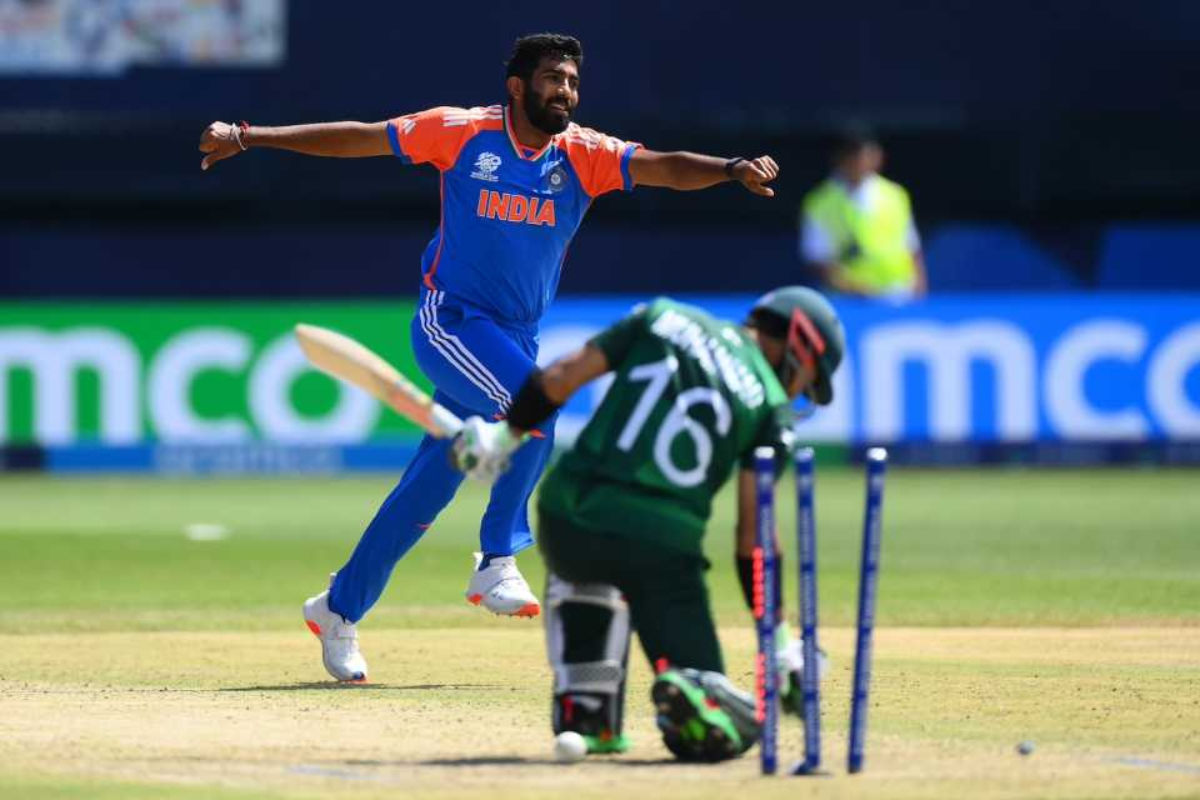Twelve overs into Pakistan’s chase against India in Sunday’s World T20 clash, the game was practically over. Pakistan found themselves 72/2. They needed 48 runs from 48 balls with 8 wickets left. As someone from New York City, thirty minutes outside where the game took place in Long Island, would say: Fuhgeddaboutit!
Fast forward 30 balls, and suddenly Pakistan need 30 from 18 deliveries. It was an insurmountable target on the difficult pitch.
How did certain triumph turn into heartbreak?
Many people will say it came down to one ball. A delivery from quick Jasprit Bumrah nipped in, rattled Mohammad Rizwan’s stumps, and unraveled Pakistan. The Bumrah ball has already become an iconic moment, and deservingly so. It’s a magical thing, carrying the weight of a clutch buzzer-beater, homerun, or goal—it awakens a crowd, gets them to roar, pushes them to cheer when all hope seems lost. But Bumrah’s ball, while this match’s most important moment, cannot alone explain Pakistan’s collapse. That story unfolds over 30 balls, from the start of the 13th over to the end of the 17th, each delivery contributing to their demise.

As the 13th over got underway, Indian captain Rohit Sharma brought on part-time bowler Hardik Pandya, which seemed unwise. Pandya had gone at nine runs an over; another like that and Pakistan would need less than a run-a-ball, truly wrangling control. But Pandya did not bowl such an over. He conceded just one, rewarding Sharma’s faith. More important, he scalped Fakhar Zaman’s wicket on a cramping short-ball.
Zaman’s dismissal began India’s comeback. A destructive force who humiliated India in the ICC Champions Trophy Final, Zaman had zoomed to 13 from seven deliveries. If he remained much longer, Pakistan would make mince meat of this chase. Pandya’s wicket not only removed a batter then, but undermined Pakistani’s opportunity to get ahead of the run-a-ball pace. Now, the pressure spiked for the two Pakistani batters at the crease to not fall behind.
Neither of those batters did well. In fairness to Rizwan and Imad Wasim, they each played sensibly. They took time to score, downplaying risk so they wouldn’t lose their wicket quickly, which would’ve halted Pakistan’s innings. The problem? They both did this. One had to make sure he lasted till the end in case this chase had to be negotiated on a tricky surface. The other, however, should’ve played like Zaman—put his foot on the gas with the hope nothing or almost nothing would be left at the chase’s end. Sadly, Rizwan and Wasim played the exact same way, knocking around singles and skimping on boundaries, thus complimenting each other at the chase’s expense. In turn, Pakistan went from a run-a-ball to needing 40 from 36, slightly losing ground.
This might explain why Rizwan tried to hack Bumrah for six on the fifteenth over’s first ball. We all know what came next. Bumrah’s ball angled in, kept low, and smashed the stumps. He ran to Virat Kohli, who punched his fists. Bumrah punched his fists too, the Indian players hugged, and fans exploded. One commentator called it poetry. The ball told a story too.

Bumrah is India’s purest fast bowler ever. At his peak, like in 2019, everyone knows this. And yet, he’s rarely been talked about as perhaps his generation’s finest quick. Nobody is to blame for this. No fan or commentator slanders Bumrah, and he certainly does not flop on the big stage. He’s simply suffered too many injuries to play at a legendary level for lengthy durations. There’s a sadness to his career, a sense that as special as he is, he’s missed out on more. It’s a testament to him, though, that he always returns to peak form after setbacks; few athletes make resiliency look so easy. That’s why the Rizwan delivery is beautiful. As it broke in, the slanting Kookaburra showed us who Bumrah is—his remarkable skill, his talent that’s been frustrated by injuries, and his drive that brings him back from such pain. The Indian crowd celebrated not only because the ball put India on top, but because it reminded them of Bumrah’s resilience.
In contrast to Bumrah’s beautiful delivery, there’s Rizwan’s ugly swing. Every Pakistani has lambasted that shot, so why add scorn. But what in the world was he thinking? Block everyone, then play the riskiest shot against Bumrah first ball back? Ridiculous! Baffling! The one possible reason is he felt heat from how he and Wasim had slowed the chase. It’s logical then. The slog’s an attempt to prevent Bumrah from squeezing the partnership further and to put Pakistan ahead of the run-a-ball pace instead of drifting behind it. But rationalizing madness does not make it any less mad; it’s silly to get aggressive the first moment you face India’s best bowler. And the aftermath showed why. After Rizwan only sent himself into the stands, Wasim and new batter Shadab Khan felt uncertain and nervous, scoring three simple runs off the over’s next five balls. Bumrah had put the squeeze on after all. And Pakistan went from needing 48 from 48 to 37 from 30; the chase had slipped from their hands.

The next over from Axar Patel was uneventful—zero wickets, no boundaries, and just two runs. But this uneventfulness is what made it devastating to Pakistan. To score two runs when you’ve fallen behind a run-a-ball pace on a tough track is to lose control. You felt that when Wasim tried to cut Patel four times for only one run. All that effort for so little reward is not “in control”; it’s desperation, the sense that you must do one insignificant thing to save yourself. Credit should go to Patel for heightening the desperation. When he saw Wasim fail to cut, he bowled outside the off-stump again and again, and shortened the time between deliveries. He didn’t give Wasim space to think outside his mental cage, and suddenly four balls had passed for just one run. There was a touch of the wily Indian spinner Ravichandran Ashwin to Patel’s bowling. Despite not producing a wicket-taking ball, his cleverness firmly put India in front. Pakistan needed 35 off of 24.
In Hardik Pandya’s next six balls, India won the game. Requiring to score fast now, Pakistan accelerated. They scored five from the over, which was still significantly behind what they needed. Worse, the one big shot from Shadab fizzled into a pop. For the second time of a Pandya short-ball, the first being Zaman’s dismissal, wicket-keeper Rishabh Pant backpedaled, twisted, and turned to take the catch. With two wickets in his final two overs then, Pandya began and capped off India’s soaring comeback. India was the favorite from here: There was one more Bumrah over, the bad pitch, and mostly Pakistan’s bowlers needing to bat. Pakistan needed 30 from 18. As those New Yorkers would say: Fuhgeddaboutit! Despite some heroics from bowler Naseem Shah with the bat, India did not relinquish their grip over the next 18 deliveries the way Pakistan tragically had over the last 30.
And so India scraped by in a classic contest that will be remembered forever. What shouldn’t be forgotten is that this close call was shaped by a 30-ball period where India dominated Pakistan. What stands out about those 30 balls is…well, yes, Bumrah’s delivery, but also India’s harmonious play. It all came together for them. Four men bowled a tight five overs backed by Sharma’s strategy and trust, perfect fielding from the likes of Pant, spirited body language from Kohli, and the crowd’s galvanizing roar. It was a dream that contrasted with Pakistan’s personally created nightmare. It had all gone wrong for the those in green at their own hands. The runs dried up due to bad strategy, wickets fell due to bad shots, their body language dipped and their supporters went silent thanks to their own bad play.

That 30-ball stretch, then, turned out to be the game within the game that determined the entire match. It was a great showcase for T20 cricket’s unappreciated complexity. Yes, it’s the shortest and least sophisticated format, but it contains the richness of any great sport. Like the best test cricket, the whole can be defined by a part, and the difference between teams’ enduring joy and agony can come down to a fleeting thirty balls.
